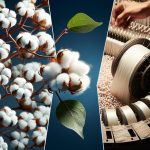I've found that rayon might not be the best for my skin or the environment. It feels nice and silky, but the way it's made involves harsh chemicals that can irritate my skin and cause other health issues. I've learned that wearing rayon can expose my skin to these toxins, which isn't great for me. Plus, its production harms the planet pretty badly. I definitely think I'm better off choosing natural fibers like cotton or silk, which are safer and feel just as good. There's a lot more to consider when thinking about what's truly good for our skin.
Table of Contents
Key Takeaways
- Rayon can expose skin to toxic chemicals, potentially causing irritations and allergies.
- Direct contact with rayon may lead to skin issues due to harsh chemical residues.
- Cotton, as a natural fiber, is safer and more breathable for direct skin contact than rayon.
- Rayon's chemical-intensive production poses health risks, impacting skin sensitivity.
- Alternatives like organic cotton, silk, and merino wool are better suited for sensitive skin.
Properties of Rayon Fabric
Rayon's main draw, its silky texture, comes from chemically altered wood pulp, but this process releases harmful toxins that pose significant health risks. It's a popular fabric because it feels great and drapes beautifully, but the downside is pretty significant. When you're dealing with rayon, you're not just talking about any fabric; it's one that comes with a heavy environmental and health cost.
The transformation from wood pulp to soft fabric isn't a clean one. It involves a cocktail of chemicals that can be rough on our planet and our health. As someone who's keen on finding skin-friendly fabrics, it's tough to ignore the fact that rayon, despite its smooth feel, mightn't be the best choice. The chemicals used in producing rayon aren't just harsh, but they linger, which means they can keep affecting the environment and potentially our health long after the fabric has been made.
Understanding this gives us a clearer picture of why rayon, despite its appealing texture and drape, mightn't align with the values of those of us looking for truly safe and sustainable options in our clothing.
Rayon's Impact on Skin Health
I've learned that wearing rayon mightn't be the best for our skin due to the toxic chemicals it can release. The more I dive into the world of synthetic fibers, the clearer it becomes that our skin, which is our largest organ, can really take a hit from these substances. When rayon is processed, it's typically treated with chemicals that can lead to not just nausea and headaches but also insomnia. Imagine what this does to our skin!
These toxic chemicals aren't just floating around in the air; they're in contact with our skin when we wear rayon clothing. This exposure can lead to skin issues, including irritations and allergies. It's kind of scary to think that what's supposed to protect us—our clothes—could actually be harming us.
Moreover, the environmental impact of producing rayon is also alarming. The pollution from manufacturing this fiber doesn't just disappear; it affects everything, including the health of our ecosystem, which in turn impacts our skin health indirectly.
From all this, it's clear that we need to be cautious about choosing rayon. Ensuring our skin's health means staying informed and possibly steering clear of fibers that carry such risks.
Comparing Rayon to Natural Fibers
So, let's talk about how rayon stacks up against natural fibers like cotton, especially in terms of comfort and moisture absorption.
We all know that feeling comfy in what we wear is key, and how our clothes handle sweat can make a big difference.
I'll break down the differences and see which one might be better for our skin and overall comfort.
Rayon Vs. Cotton Comfort
When comparing rayon to natural fibers like cotton, it's clear that cotton often wins out in terms of comfort for your skin. Here's why:
- Breathability: Cotton is far more breathable than rayon. This means less sweat and irritation, especially for those with sensitive skin.
- Chemical Exposure: Rayon involves chemicals in its production that can lead to skin irritation. In contrast, cotton is processed in a much cleaner way, making it safer for direct skin contact.
- Environmental Impact: Cotton is generally more eco-friendly. The less harsh production process means fewer pollutants that can indirectly affect skin health through environmental damage.
Choosing cotton clearly offers better comfort and health benefits for your skin!
Moisture Absorption Differences
Despite its disadvantages, rayon outperforms natural fibers like cotton in moisture absorption. This synthetic fabric shines particularly in humid climates because of its ability to wick moisture away, keeping your skin dry and comfy. It's a game-changer for anyone who wants their skin to feel cool and irritation-free.
Here's a quick comparison:
| Fiber Type | Moisture Absorption Capability |
|---|---|
| Rayon | High |
| Cotton | Moderate |
| Linen | Moderate |
| Polyester | Low |
| Silk | Low |
Chemicals Used in Rayon Production
When we look at how rayon is made, it's clear there are some serious concerns.
The process uses really harsh chemicals like carbon disulfide, which can make people sick with symptoms like nausea and headaches.
Plus, these substances are bad for the environment, which makes me think twice about using rayon products.
Toxicity of Production Chemicals
The chemicals used in making rayon aren't only harmful to our health but also damage the environment. When exploring the toxicity of rayon's production chemicals, it's crucial to consider:
- Toxic Substances: The processes emit harmful chemicals that pollute air and water, posing major health risks.
- Skin Irritations and Allergic Reactions: Direct contact with rayon or its fumes can lead to uncomfortable skin issues or even severe allergies.
- Environmental Impact: The chemical waste from rayon production contributes to environmental degradation, affecting ecosystems and human communities alike.
Understanding these aspects helps us gauge how rayon mightn't be the best choice if you're aiming for a skin-friendly and eco-conscious wardrobe.
Health Impact of Chemicals
Now, let's look at how the chemicals used in rayon production affect our health.
The process involves some pretty harsh substances like carbon disulfide, sodium hydroxide, and sulfuric acid. These chemicals aren't just bad for the environment; they can seriously mess with our health. Exposure to them can lead to nausea, headaches, and even insomnia.
That's not all, though. If you've got sensitive skin or are prone to allergies, rayon mightn't be your friend. These chemicals can cause skin irritations and other annoying skin conditions.
It's pretty clear that the stuff used to make rayon isn't great for our health or skin. It's worth thinking twice before opting for rayon-based products.
Alternatives to Rayon for Sensitive Skin
Considering rayon's potential for skin irritation, I've started exploring natural fabric alternatives that are gentler on sensitive skin. Here's a rundown of my top picks:
- Cotton: It's the go-to for comfort, especially organic cotton, which is produced without harsh chemicals. Its breathability and soft texture make it ideal for those with sensitive skin.
- Silk: Known for its luxurious feel, silk is hypoallergenic and a natural fungal repellent, which means it's less likely to irritate. It also helps regulate body temperature, keeping you cool on hot days and warm when it's chilly.
- Merino Wool: Unlike regular wool, merino is super fine and soft, which doesn't itch or irritate the skin. It's great for temperature regulation and moisture-wicking, making it perfect for both summer and winter wear.
Choosing the right fabric is crucial, especially if you've got sensitive skin. I've found that investing in these natural fibers not only soothes my skin but also supports a healthier lifestyle. Plus, they feel amazing against the skin and offer long-lasting comfort, making them a smart choice for anyone looking to avoid synthetic irritants.
Environmental Concerns of Rayon Production
While exploring alternatives to rayon, I also learned about its significant environmental drawbacks. It turns out that producing rayon isn't just tough on our planet; it can be pretty rough on our health too. The process releases some seriously nasty chemicals like carbon disulfide, sodium hydroxide, and sulfuric acid. These aren't just bad for the air and water around us; they can mess with the health of your skin and cause irritation, especially if you're sensitive.
What's more, these toxic substances aren't just a minor issue—they lead to major environmental degradation. Think about it: the chemicals needed to transform wood pulp into rayon are harsh, contributing to pollution that affects everything from our ecosystems to our own bodies. We're talking about potential nausea, headaches, and even insomnia.
Frequently Asked Questions
What Is the Best Fabric for Your Skin?
The best fabric for your skin is definitely cotton. It's breathable, soft, and doesn't irritate. I always choose cotton because it's gentle and works well for all skin types, especially sensitive skin.
Is Rayon OK for Skin?
I wouldn't recommend rayon for skin contact. It's made from chemically altered wood pulp and can release harmful substances, potentially causing skin irritation, allergies, or worse health issues like nausea and headaches.
Is Rayon Better Than Cotton?
I'd say cotton's better than rayon. It's more breathable, natural, and gentle on the skin. Rayon, although versatile, isn't as skin-friendly due to the harsh chemicals involved in its production.
What Is the Healthiest Fabric to Wear?
I'd say the healthiest fabrics to wear are natural ones like cotton, silk, and hemp. They're gentle on the skin and don't carry the health risks associated with synthetic options like rayon.
- Chamois Fabric Wholesale: Top Suppliers and Manufacturers - June 22, 2025
- Micro Chamois Fabric by the Yard: Best Suppliers - June 22, 2025
- PVA Chamois Fabric by the Yard: A Comprehensive Buying Guide - June 22, 2025






